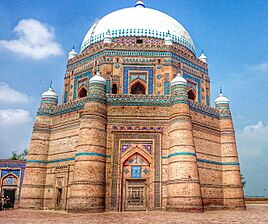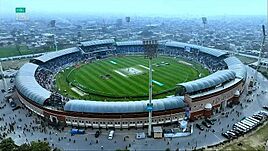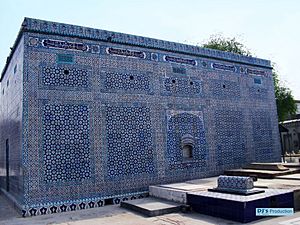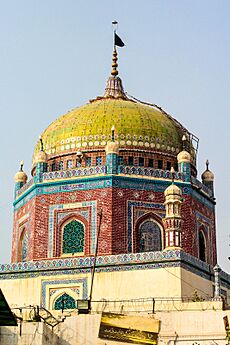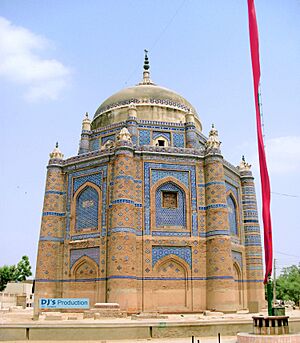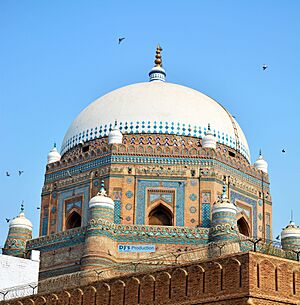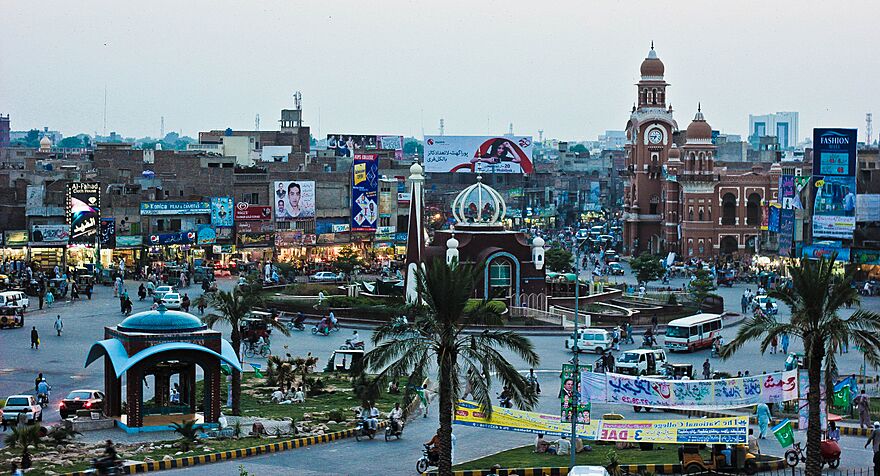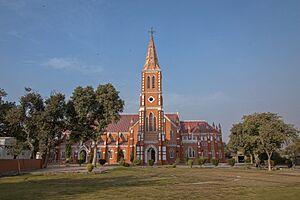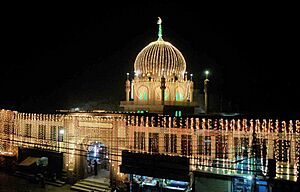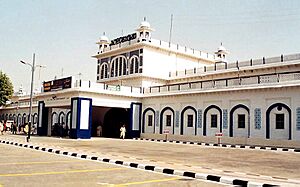Multan facts for kids
Quick facts for kids
Multan
ملتان
|
|
|---|---|
|
Metropolis
|
|
|
Clockwise from top:
Tomb of Shah Rukn-e-Alam, Ghanta Ghar, Chenab river, Multan Cricket Stadium, Shahi Eid Gah Mosque, Blue-tiled tomb of Shah Gardez |
|
| Country | |
| Province | |
| Division | Multan |
| Autonomous towns | 6 |
| Union council | 4 |
| Government | |
| • Type | Metropolitan Corporation |
| Area | |
| • City | 3,721 km2 (1,437 sq mi) |
| • Metro | 560 km2 (220 sq mi) |
| Population
(2017)
|
|
| • City | 1,827,001 |
| • Rank | 7th, Pakistan |
| • Density | 491.00/km2 (1,271.68/sq mi) |
| • Demonym | Multani |
| Time zone | UTC+05:00 (PKT) |
| Area code(s) | 061 |
Multan (مُلتان), pronounced mool-taan, is a big city in Punjab, Pakistan. It sits on the bank of the Chenab river. Multan is one of Pakistan's five largest cities and is an important center for culture, religion, and business in the Punjab region. It is also one of the oldest cities in Asia, with a history that goes back a very long time.
Multan became part of the Achaemenid Empire in the early 500s BC. The ancient city was home to the famous Multan Sun Temple. Alexander the Great even attacked it during his Mallian Campaign. Later, in 712 CE, the Muslim military leader Muhammad bin Qasim took control of Multan after conquering Sindh. In the 800s, it became the capital of the Emirate of Multan.
During the medieval period, Multan was ruled by the Ghaznavids and the Delhi Sultanate. In 1445, it became the capital of the Langah Sultanate. Later, the Mughal emperor Akbar made it one of the provinces of the Mughal Empire. In 1848, the British took Multan from the Sikh Empire, and it became part of British Punjab.
In the medieval Islamic Indian subcontinent, Multan was a very important trading hub and a great place for learning. Many Sufi mystics came to the city in the 1000s and 1100s. This made Multan a major spiritual center in South Asia, earning it the nickname "City of Saints." The city, along with nearby Uch, is well-known for its many Sufi shrines from that time.
Contents
- What Does the Name Multan Mean?
- A Look at Multan's History
- Multan's Geography
- Multan's City Layout
- People of Multan
- How Multan is Governed
- Where People Live in Multan
- Getting Around Multan
- Education in Multan
- Multan's Heritage
- Sports in Multan
- Famous People from Multan
- Sister Cities
- See also
What Does the Name Multan Mean?
The exact origin of Multan's name is not fully clear. An old name for the city was Malli-istan, which came from the Malli tribe that lived there. Some people think the name might come from the god worshipped at the ancient Multan Sun Temple. Others suggest it comes from the Old Persian word mulastāna, meaning 'frontier land', or the Sanskrit word mūlasthāna.
A Look at Multan's History
How Multan Began
The area around Multan has several old archaeological sites. These sites date back to the early Harappan period of the Indus Valley Civilization, from 3000 BC to 2800 BC. According to old Hindu texts, a wise man named Kashyapa founded Multan. These texts also say that Multan was the capital of the Trigarta Kingdom during the Kurukshetra War, which is a central part of the Hindu epic poem, the Mahabharata.
Ancient Multan was a center for sun worship, based at the Multan Sun Temple. A Greek admiral named Skylax visited the temple in 515 BCE. The Greek historian Herodotus also mentioned the temple in 400 BC.
Alexander the Great's Invasion
Many believe Multan was the capital of the Malli people, which Alexander the Great conquered in 326 BCE. This was part of his Mallian Campaign. The Malli people and nearby tribes gathered a large army of 90,000 soldiers to fight Alexander's 50,000 Greeks. This was the biggest army the Greeks faced in the subcontinent.
During the siege of the city's fort, Alexander reportedly jumped into the inner part of the fort. He was wounded by an arrow that went into his lung, leaving him badly hurt. After a fierce battle at a place called 'Khooni Burj', the Mallian army finally gave up. In Alexander's time, Multan was on an island in the Ravi river, which has changed its path many times over the centuries.
In the mid-400s CE, the city was attacked by the White Huns, a group of nomadic people led by Toramana. They conquered Multan after a tough fight but did not stay long. By the mid-600s CE, Chach of Alor, a Hindu king, conquered Multan.
The Islamic Conquest
- Further information: Umayyad Caliphate and Abbasid Caliphate
A Muslim army first invaded Multan in 664 CE, when an Arab general named Mohalib took the city. However, they did not try to keep control of it. After conquering Sindh, Muhammad ibn Qasim captured Multan from Raja Dahir in 712 CE, after a two-month siege. After ibn Qasim's conquest, most of the city's people remained non-Muslim for several decades under the Umayyad Caliphate.
The Emirate of Multan (800s and 900s)
By the mid-800s, the Banu Munabbih family came to rule Multan and set up the Emirate of Banu Munabbih. They ruled for about a century.
During this time, the Multan Sun Temple was very important. The 900s Arab geographer Al-Muqaddasi noted that it was in a very busy part of the city. The Hindu temple brought in a lot of tax money for the Muslim rulers, sometimes as much as 30% of the government's income. Multan was even called Faraj Bayt al-Dhahab, which means "Frontier House of Gold" in Arabic, showing how important the temple was to the city's economy.
The 900s Arab historian Al-Masudi said Multan was where caravans from Islamic Khorasan (Central Asia) would gather. The Persian geographer Estakhri noted that Multan was about half the size of Sindh's capital, Mansura, but had more people. Both cities spoke Arabic, but people in Multan also spoke Persian, which was helpful for trade with Khorasan.
By the mid-900s, Multan came under the influence of the Qarmatian Ismailis. These Qarmatians had been forced out of Egypt and Iraq. They took control of Multan from the Banu Munabbih and set up the Emirate of Multan, promising loyalty to the Ismaili Fatimid Dynasty in Cairo. The Qarmatian Ismailis were against Hindu pilgrims worshipping the sun. They destroyed the Sun Temple and broke its revered idol in the late 900s. They built an Ismaili mosque on top of the temple's ruins.
Multan from the 1000s to 1500s CE
- Further information: Ghaznavids
In 1005, Mahmud of Ghazni attacked Multan's Qarmatian ruler, Abul Fateh Daud. The city surrendered, and Fateh Daud was allowed to keep control if he followed Sunnism. In 1010, Mahmud attacked Daud again, removed him from power, and ended Ismaili rule, bringing back Sunni Islam. He destroyed the Ismaili mosque and rebuilt the city's old Sunni mosque, which was first built by Muhammad bin Qasim.
After Mahmud's death in 1030, Multan became independent from the Ghaznavid empire and came under Ismaili rule again. Shah Gardez, who arrived in Multan in 1088, is said to have helped restore the city.
Ghurid Rule
- Further information: Ghurid dynasty
In 1175, Muhammad Ghori conquered Ismaili-ruled Multan. He used the city as a base for his military campaigns. Multan then became part of the Ghurid Sultanate.
Mamluk Rule
After the first Mamluk Sultan died in 1210, Multan was ruled by Nasiruddin Qabacha. In 1222, he successfully fought off an invasion by Sultan Jalal ad-Din Mingburnu. Qabacha also took control of Lahore many times. He defended Multan from a 40-day siege by Mongol forces.
After Qabacha's death, the Turkic king Iltutmish, the third Sultan of the Mamluk dynasty, captured Multan. The Punjabi poet Baba Farid was born near Multan in the 1200s.
Mongol forces tried to capture Multan several times in the 1200s but were often pushed back. The city's walls were even taken down at one point.
Khalji Invasion
In 1296, Delhi Sultan Alauddin Khalji sent his army to conquer the Multan region. The famous Sufi singer, poet, and scholar Amir Khusrau visited Multan during this time. He wrote that Multan was a gateway to India and a center for knowledge. Scholars, traders, and messengers traveled through Multan on their way to Delhi.
Tughluq Dynasty
In the 1320s, Ghiyath al-Din Tughluq conquered Multan. He became the governor of Multan and other regions. He founded the Turkic Tughluq dynasty, the third dynasty of the Delhi Sultanate. He fought 28 battles against the Mongols from Multan and saved the region. People gave him the title Ghazi ul Mulk, meaning "Warrior of the Country."
Ghiyath al-Din's son, Muhammad Tughluq, was born in Multan. The Tomb of Shah Rukn-e-Alam was finished during the Tughluq era. It is believed to have been built for Ghiyath al-Din, but was later given to the family of Rukn-e-Alam.
The famous Arab explorer Ibn Battuta visited Multan in the 1300s. He noted that Multan was a trading center for horses from as far away as the Russian Steppe.
Timurid Dynasty
- Further information: Timurid Empire
In 1397, Multan was attacked by Tamerlane's grandson, Pir Muhammad. His forces captured the city in 1398 after a six-month siege. Khizr Khan, the governor of Multan, became an ally of Amir Timur. In 1414, Khizr Khan captured Delhi and started the short-lived Sayyid dynasty.
Langah Sultanate
Multan then came under the rule of the Langah people, who started the Langah Sultanate. Multan became very prosperous during the reign of Shah Husayn (1469 to 1498). Many Baloch settlers came to the city at his invitation. The Sultanate's borders reached nearby cities like Chiniot and Shorkot.
The Langah Sultanate ended in 1525 when the city was invaded by the Arghun dynasty.
Suri Dynasty
- Further information: Sur Empire
In 1541, the Pashtun king Sher Shah Suri captured Multan. He built a road between Lahore and Multan to connect Multan to his large Grand Trunk Road project. This road helped trade caravans travel from medieval India to West Asia.
Medieval Trade
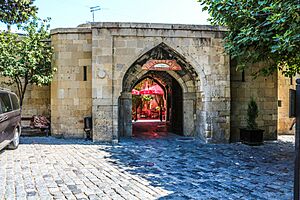
Multan was a major trading center in medieval Islamic India, especially for trade with the Islamic world. The city became very important for business due to the stable rule of the Delhi Sultanate and the Mughals. The Multani Caravanserai in Baku, Azerbaijan, was built in the 1400s to house merchants from Multan visiting that city. This shows how far Multan's trade influence reached.
Multan remained an important trading center until it was damaged by many invasions in the 1700s and 1800s. Many of Multan's merchants then moved to Shikarpur in Sindh.
Mughal Period (Province of Multan)
After the Mughal Emperor Akbar conquered Upper Sindh, his army captured Multan in 1557. This brought Multan back under Mughal rule. Emperor Akbar made Multan city the center of the province of Multan. This was one of his original twelve large administrative provinces. It covered southern Punjab and parts of Khyber and Balochistan. It was one of the largest Mughal provinces in terms of land and people.
In 1627, walls were built around Multan on the orders of Murad Baksh, son of Shah Jahan. In 1648, the future emperor Aurangzeb was made Governor of Multan and Sindh. He held this position until 1652.
In 1680, the famous Punjabi poet, Bulleh Shah, who is seen as a saint by both Sufis and Sikhs, was born in Uch, Multan province.
In the late 1600s, Multan's trade suffered because the nearby river changed its course. This made it harder for traders to reach the Arabian Sea. Multan faced tough times as the Mughal Empire became weaker after Emperor Aurangzeb's death in 1707.
"Abode of Peace" Era
Under Mughal rule, Multan had 200 years of peace. During this time, the city was known as Dar al-Aman ("Abode of Peace"). Multan was an important center for farming and making cotton textiles. It was also a place for minting currency and making tiles.
Later Invasions
Nader Shah conquered the region in 1739 as part of his invasion of the Mughal Empire. Even with this invasion, Multan remained a top commercial center in northwest India for most of the 1700s.
In 1752, Ahmad Shah Durrani captured Multan. The city's walls were rebuilt in 1756. In 1758, the Marathas briefly took Multan, but Durrani recaptured it in 1760. After many invasions, Multan changed from being a major global trading center to a regional one.
Sikh Empire
In 1772, Ahmed Shah Durrani's son Timur Shah lost Multan to Sikh forces. However, the founder of the Sikh religion, Guru Nanak, had visited the city much earlier.
The city returned to Afghan rule in 1778. In 1818, the armies of Kharak Singh and Misr Diwan Chand attacked Multan. They used a huge cannon called Zamzama, which quickly broke Multan's defenses. Misr Diwan Chand led the Sikh armies to a big victory. The Multan fort fell on March 2, 1818, in the Battle of Multan.
The Sikh conquest of Multan showed Ranjit Singh's power over the Afghans. Diwan Sawan Mal Chopra was appointed to govern the city for the next 25 years. After the Sikh conquest, Multan became less important as a trading post. However, its population grew from about 40,000 in 1827 to 60,000 by 1831.
The 1848 Multan Revolt
The 1848 Multan Revolt began on April 19, 1848. Local Sikhs, loyal to Diwan Mulraj Chopra, killed two British officials, Vans Agnew and Lieutenant Anderson. These British visitors were in Multan for a ceremony to replace Mulraj Chopra as ruler.
The rebellion spread across the Multan region, led by Mulraj Chopra. This revolt started the Second Anglo-Sikh War. The British eventually conquered the Sikh Empire in February 1849.
British Rule
By December 1848, the British had captured parts of Multan city and destroyed the Multan Fort. In January 1849, the British had a force of 12,000 soldiers to conquer Multan. On January 22, 1849, the British broke through the walls of the Multan Fort, leading to Mulraj and his forces surrendering. Between the 1890s and 1920s, the British built a large network of canals in the Multan region.
After Pakistan's Independence in 1947
Multan lost its very important position as British rule grew stronger. After Pakistan became independent in 1947, Multan became less important politically. The old fort was in ruins, and many roads were unpaved.
Most of the people in Multan were Muslim and supported the Muslim League and the Pakistan Movement. After Pakistan's independence in 1947, the Hindu and Sikh minorities moved to India. Some Muslim refugees from India settled in Multan. Today, Multan is one of Pakistan's six largest cities and remains an important place in Southern Punjab.
Multan's Geography
Land and Location
Multan is located in Punjab and covers an area of 560 square kilometres (220 sq mi). The closest important cities are Dera Ghazi Khan and Bahawalpur. Multan is in a bend formed by five rivers in central Pakistan. The Sutlej River separates it from Bahawalpur, and the Chenab River separates it from Muzaffar Garh. The area around the city is a flat plain with orchards and deserts, used for growing citrus fruits and mangoes.
Multan is surrounded by the Sulaiman mountain range. The most famous peak in these mountains is Takht-e-Sulaiman, or "Throne of Prophet Solomon," which is 3,487 meters (11,440 ft) high.
Climate and Weather
Multan has a hot desert climate with extremely hot summers and mild winters. The average yearly rainfall is 186 millimetres (7.3 in).
Multan is known for having some of the hottest weather in Pakistan. The highest temperature ever recorded was about 52 °C (126 °F), and the lowest was about −1 °C (30 °F).
| Climate data for Multan (1991–2020) | |||||||||||||
|---|---|---|---|---|---|---|---|---|---|---|---|---|---|
| Month | Jan | Feb | Mar | Apr | May | Jun | Jul | Aug | Sep | Oct | Nov | Dec | Year |
| Record high °C (°F) | 28.3 (82.9) |
32.0 (89.6) |
39.0 (102.2) |
45.0 (113.0) |
48.9 (120.0) |
52.0 (125.6) |
52.2 (126.0) |
45.0 (113.0) |
42.5 (108.5) |
40.8 (105.4) |
36.0 (96.8) |
29.0 (84.2) |
52.2 (126.0) |
| Mean daily maximum °C (°F) | 19.7 (67.5) |
23.3 (73.9) |
28.7 (83.7) |
35.8 (96.4) |
40.9 (105.6) |
41.6 (106.9) |
39.0 (102.2) |
37.4 (99.3) |
36.4 (97.5) |
34.0 (93.2) |
28.1 (82.6) |
22.5 (72.5) |
32.3 (90.1) |
| Daily mean °C (°F) | 12.7 (54.9) |
16.2 (61.2) |
21.5 (70.7) |
28.6 (83.5) |
33.4 (92.1) |
35.3 (95.5) |
34.1 (93.4) |
32.4 (90.3) |
31.0 (87.8) |
26.8 (80.2) |
20.3 (68.5) |
14.9 (58.8) |
25.6 (78.1) |
| Mean daily minimum °C (°F) | 5.7 (42.3) |
9.0 (48.2) |
14.6 (58.3) |
20.5 (68.9) |
25.9 (78.6) |
28.9 (84.0) |
29.2 (84.6) |
28.2 (82.8) |
25.7 (78.3) |
19.5 (67.1) |
12.5 (54.5) |
7.2 (45.0) |
18.9 (66.1) |
| Record low °C (°F) | −2.2 (28.0) |
−1.0 (30.2) |
3.3 (37.9) |
9.4 (48.9) |
13.5 (56.3) |
20.0 (68.0) |
21.1 (70.0) |
21.1 (70.0) |
16.7 (62.1) |
8.9 (48.0) |
0.6 (33.1) |
−1.1 (30.0) |
−2.2 (28.0) |
| Average precipitation mm (inches) | 7.5 (0.30) |
17.6 (0.69) |
20.3 (0.80) |
14.3 (0.56) |
13.5 (0.53) |
17.6 (0.69) |
49.1 (1.93) |
43.5 (1.71) |
32.8 (1.29) |
7.6 (0.30) |
1.3 (0.05) |
6.1 (0.24) |
231.2 (9.09) |
| Average precipitation days (≥ 1.0 mm) | 1.6 | 2.4 | 2.6 | 2.8 | 1.7 | 1.9 | 3.0 | 3.1 | 1.6 | 0.9 | 0.3 | 0.9 | 22.8 |
| Mean monthly sunshine hours | 181.5 | 190.2 | 241.1 | 266.2 | 283.1 | 252.7 | 248.5 | 253.9 | 257.6 | 262.1 | 216.4 | 198.4 | 2,851.7 |
| Source: NOAA | |||||||||||||
Multan's climate is mainly affected by:
- Western Disturbances: These happen in winter (December to February) and bring moderate rain, sometimes with hailstorms.
- Dust Storms: These occur in summer due to large-scale deforestation and can bring strong winds.
- Heat Waves: In May and June, temperatures can reach nearly 50 °C (122 °F).
- South West Monsoon: This season follows the hottest months, from June to September. Monsoon rains cool down temperatures and can bring heavy storms.
- Continental Air: During other months, the weather is usually clear with little to no rain.
Multan's City Layout
Multan's city design is like other old cities in South Asia, such as Peshawar, Lahore, and Delhi. All these cities were built near a major river and had an old walled city and a royal fort. However, Multan's royal fort was mostly destroyed by the British in 1848, which changed the city's look.
The old homes in Multan show how people cared about privacy and protection from the harsh climate. The city has many small, private streets branching off from markets and main roads.
A special Multani style of architecture began in the 1300s with the building of tombs. This style uses large brick walls with wooden supports and inward-sloping roofs. This style also influenced the design of homes in the city.
People of Multan
| Historical population | ||
|---|---|---|
| Year | Pop. | ±% |
| 1881 | 68,674 | — |
| 1891 | 74,562 | +8.6% |
| 1901 | 87,394 | +17.2% |
| 1911 | 99,243 | +13.6% |
| 1921 | 84,806 | −14.5% |
| 1931 | 119,457 | +40.9% |
| 1941 | 143,000 | +19.7% |
| 1951 | 190,000 | +32.9% |
| 1961 | 358,000 | +88.4% |
| 1972 | 539,000 | +50.6% |
| 1981 | 732,000 | +35.8% |
| 1998 | 1,197,384 | +63.6% |
| 2017 | 1,827,001 | +52.6% |
In 1998, Multan city had a population of 1,078,245 people. By the 2017 census, Multan's population grew to 1.827 million. For every 1000 males, there were 950 females. The literacy rate was 74.69%, meaning most people could read and write. About 24% of the population was under 10 years old.
Languages Spoken
In 2017, 42.10% of the people spoke Saraiki, 29.25% spoke Punjabi, 26.77% spoke Urdu, and 1.18% spoke Pashto as their main language.
Religions in Multan
Islam is the main religion, followed by 98.54% of the population. Christians make up 1.36%. There are also small numbers of Hindus and Sikhs.
| Religious group |
1868 | 1881 | 1891 | 1901 | 1911 | 1921 | 1931 | 1941 | 2017 | 2023 | ||||||||||
|---|---|---|---|---|---|---|---|---|---|---|---|---|---|---|---|---|---|---|---|---|
| Pop. | % | Pop. | % | Pop. | % | Pop. | % | Pop. | % | Pop. | % | Pop. | % | Pop. | % | Pop. | % | Pop. | % | |
| Islam |
24,828 | 54.44% | 36,294 | 52.85% | 39,765 | 53.33% | 46,899 | 53.66% | 55,686 | 56.11% | 55,864 | 65.87% | 72,134 | 60.38% | 81,613 | 57.16% | 1,808,475 | 98.99% | 2,208,159 | 98.54% |
| Hinduism |
19,812 | 43.45% | 29,962 | 43.63% | 32,130 | 43.09% | 36,947 | 42.28% | 38,341 | 38.63% | 25,339 | 29.88% | 41,999 | 35.16% | 56,602 | 39.65% | 1,728 | 0.09% | 1,617 | 0.07% |
| Christianity |
195 | 0.43% | N/A | N/A | 1,672 | 2.24% | 1,777 | 2.03% | 2,105 | 2.12% | 1,955 | 2.31% | 1,823 | 1.53% | 680 | 0.48% | 15,766 | 0.86% | 30,380 | 1.36% |
| Sikhism |
83 | 0.18% | 661 | 0.96% | 961 | 1.29% | 1,588 | 1.82% | 2,659 | 2.68% | 1,573 | 1.85% | 2,960 | 2.48% | 2,665 | 1.87% | N/A | N/A | 80 | 0% |
| Jainism |
N/A | N/A | 46 | 0.07% | 24 | 0.03% | 134 | 0.15% | 388 | 0.39% | 28 | 0.03% | 424 | 0.35% | 499 | 0.35% | N/A | N/A | N/A | N/A |
| Zoroastrianism |
N/A | N/A | N/A | N/A | 9 | 0.01% | 49 | 0.06% | 58 | 0.06% | 47 | 0.06% | 117 | 0.1% | N/A | N/A | N/A | N/A | 2 | 0% |
| Judaism |
N/A | N/A | N/A | N/A | 0 | 0% | N/A | N/A | 6 | 0.01% | 0 | 0% | 0 | 0% | N/A | N/A | N/A | N/A | N/A | N/A |
| Ahmadiyya |
N/A | N/A | N/A | N/A | N/A | N/A | N/A | N/A | N/A | N/A | N/A | N/A | N/A | N/A | N/A | N/A | 928 | 0.05% | 503 | 0.02% |
| Others | 684 | 1.5% | 1,711 | 2.49% | 1 | 0% | 0 | 0% | 0 | 0% | 0 | 0% | 0 | 0% | 929 | 0.65% | 104 | 0.01% | 206 | 0.01% |
| Total population | 45,602 | 100% | 68,674 | 100% | 74,562 | 100% | 87,394 | 100% | 99,243 | 100% | 84,806 | 100% | 119,457 | 100% | 142,768 | 100% | 1,827,001 | 100% | 2,240,947 | 100% |
How Multan is Governed
Government officials called Nazims (Mayors) manage Multan. Multan District covers 3,721 square kilometers and has four main areas called tehsils: Multan City, Multan Saddar, Shujabad, and Jalalpur Pirwala.
The Multan Development Authority (MDA) manages an area of 560 square kilometers. This includes important places like Bahauddin Zakariya University and industrial areas. In 2022, the MDA expanded its area, making Multan the 4th most populated city in Pakistan.
In 2005, Multan was reorganized into a City District with six self-governing towns:
- Bosan
- Shah Rukan e Alam
- Mumtazabad
- Sher Shah
- Shujabad
- Jalalpur Pirwala
Where People Live in Multan
- Shah Rukan e Alam
- Multan Cantt
- Shah Faisal Colony
- Gulgasht Colony
- Zakariya Town
Getting Around Multan
Motorways
Multan is connected to major motorways. The M4 goes north to Faisalabad, and the M5 goes south to Sukkar. The M4 also connects to the M3 (to Lahore) and the M2 (to Islamabad and Peshawar). The M5 will connect to Karachi in the future.
Multan is on the Karachi–Lahore Motorway (M3), which is a 6-lane road being built as part of the China Pakistan Economic Corridor. Traveling from Lahore to Multan now takes 4 hours on the M3 and M4 motorways.
The M-5 motorway, which is 392 kilometers long, connects Multan to Sukkar and opened in 2019. It will connect to Karachi when the Sukkar-Karachi Motorway is finished.
Rail Travel
Multan is connected by train to all parts of Pakistan. It is on the main railway line between Karachi, Peshawar, Lahore, and Quetta. The Main Line-1 Railway is being upgraded to allow trains to travel up to 160 kilometers per hour.
From Multan, you can take trains to Khanewal, Lodhran, and Muzafargarh. Multan Cantonment railway station is Multan's main train station.
Bus Rapid Transit (Metro Bus)
The Multan Metrobus is a special bus line that started in January 2017. It has 21 stations along an 18.5-kilometer route, with 12.5 kilometers of the route being elevated (above ground). The Metrobus starts at Bahauddin Zakariya University in northern Multan and goes south, passing by the old city, before ending at Kumharanwala Chowk in eastern Multan.
The service uses 35 buses and serves up to 95,000 passengers daily, especially students. Multan plans to have a total of 4 Metrobus lines covering 68.82 kilometers in the future.
Air Travel
Multan International Airport is located 10 kilometers west of Multan's city center. It offers flights throughout Pakistan and to countries like Bahrain, Oman, Qatar, Saudi Arabia, and the United Arab Emirates.
In March 2015, a new airport terminal was opened. After this, the number of passengers increased greatly, from 384,571 in 2014–2015 to 904,865 in 2015–2016.
Education in Multan
Bahauddin Zakariya University is the main university for higher education in this region. It is the second largest university in Punjab.
Other universities and colleges include Muhammad Nawaz Shareef University of Agriculture Multan, Air University Multan Campus, NFC Institute of Engineering and Technology, Nishat School and College, Nishtar Medical University, Emerson University, Multan Public School, University of Education campus, Times Institute, Multan Medical and Dental College, Institute of Southern Punjab, Bakhtawar Amin Medical College, and Women University Multan. In July 2021, Pakistan opened its first government-run school for transgender students in Multan.
Multan's Heritage
Prahladpuri Temple
The Prahladpuri Temple is on a raised platform inside the Fort of Multan, next to the tomb of Hazrat Baha’ul Haq Zakariya. A mosque was later built next to the temple.
The original Prahladpuri Temple is said to have been built by Prahlad, the son of Hiranyakashipu, who was a king of Multan.
Famous Saints of Multan
- Shah Yousaf Gardezi (died 1136)
- Mai Maharban (1000s/1100s)
- Bahauddin Zakariya (1170–1267)
- Shah Rukne Alam (1251–1335)
- Khawaja Awais Kagha (died 1300)
- Syed Musa Pak (died 1592)
- Hafiz Muhammad Jamal Multani (1747–1811)
- Syed Ata Ullah Shah Bukhari (1892–1961)
- Syed Noor ul Hassan Bukhari (1902–1983)
- Ahmad Saeed Kazmi (1913–1986)
Sports in Multan
The Multan Cricket Stadium has hosted many international cricket matches. Ibn-e-Qasim Bagh Stadium is another stadium in Multan, mainly used for football and other sports.
Multan is home to the Multan Sultans, a team in the Pakistan Super League. The Multan Tigers, a local cricket team, also played in domestic tournaments. Multan has produced many international cricketers, including Inzamam-ul-Haq, Waqar Younis, Mushtaq Ahmed, and Sohaib Maqsood.
| Club | League | Sport | Venue | Established |
|---|---|---|---|---|
| Multan Sultans | Pakistan Super League | Cricket | Multan Cricket Stadium | 2018 |
| Multan Tigers | National One Day Championship/National T20 Cup | Cricket | Multan Cricket Stadium | 2004 |
Famous People from Multan
- Rukn-e-Alam, a saint from the 1200s/1300s
- Shah Mehmood Qureshi, a politician and former Foreign Minister of Pakistan
- Yousaf Raza Gillani, a politician and former Prime Minister of Pakistan
- Ghiyath al din Tughlaq, a governor of Multan who became an emperor
- Aurangzeb, a governor of Multan province and later a Mughal emperor
- Khizr Khan, a 15th-century emperor
- Javed Hashmi, a politician
- Malik Muhammad Rafique Rajwana, a lawyer and politician
- Malik Aamir Dogar, a lawyer and politician
- Fariduddin Ganjshakar, a 12th-century Punjabi Muslim preacher
- Inzamam-ul-Haq, a former cricketer and captain
- Diwan Mulraj Chopra, a governor
- Mazhar Kaleem, a writer
- H. Gobind Khorana (Nobel Prize winner)
Sister Cities
Multan has sister city relationships with:
 Cairo, Egypt
Cairo, Egypt Konya, Turkey
Konya, Turkey Rasht, Iran
Rasht, Iran Shihezi, China
Shihezi, China Ganja, Azerbaijan
Ganja, Azerbaijan Xi'an, China (since March 28, 2019)
Xi'an, China (since March 28, 2019)
See also
 In Spanish: Multán para niños
In Spanish: Multán para niños


